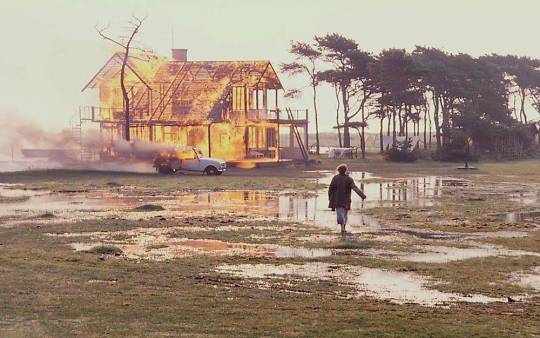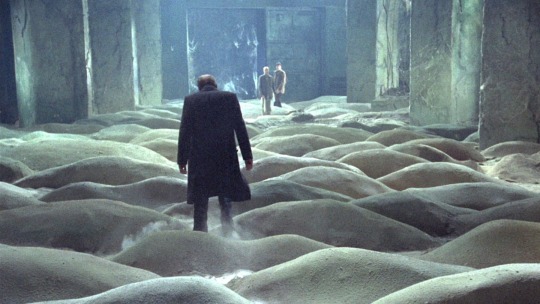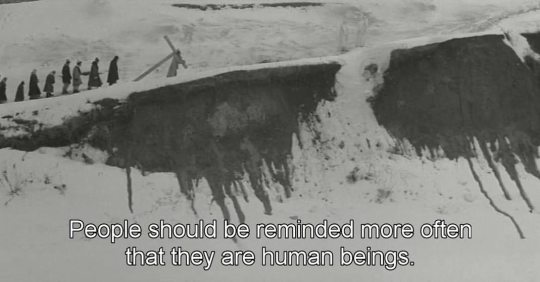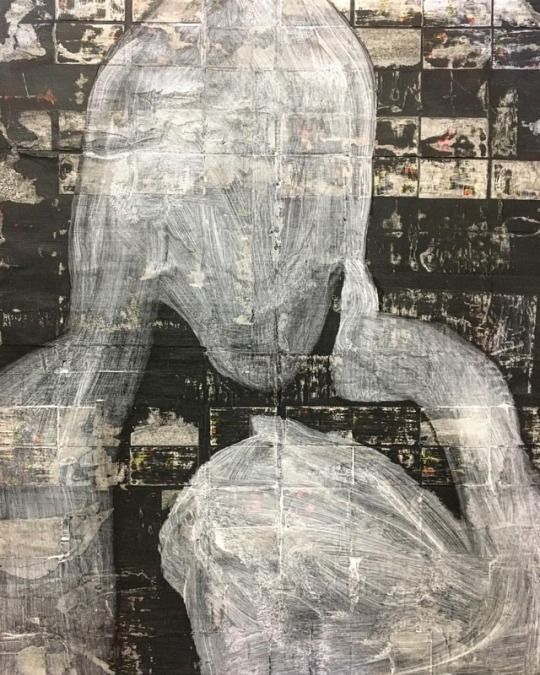#andreirublev
Explore tagged Tumblr posts
Photo

Do you know how one of the most famous Andrei Rublev’s icons “The Savior” was found? The story goes that the holy image was spotted in a dilapidated woodshed on the territory of the Assumption Cathedral in Zvenigorod. As you see in the featured picture, the icon has seen better days. It was a miracle that it was discovered by the collector, restorer, and icon painter Gregory Chirikov in 1919. If it weren’t for him, the precious piece of religious art could have been lost forever.
https://russianicon.com/the-saviour-andrei-rublev-s-russian-icon-that-was-almost-lost/
#andreirublev#savior#christ#jesuschrist#christtheredeemer#zvenigorod#christianity#russianicon#russianicons#russianiconcollection#antiqueicon#iconography#orthodoxy#orthodoxicon#christianart#orthodoxart#religiousicons
67 notes
·
View notes
Text
Ranking : Andrei Tarkovsky (1932-1986)

One of the biggest breakthrough moments of my lifelong film fandom was the deep dive into The Story of Film : An Odyssey, a 2011 documentary from director Mark Cousins and the Glasgow-based Hopscotch Films. The 15-part documentary stepped outside of the realms of Hollywood (which usually finds itself as the sole participant in many documentaries that center around film), and instead, focuses on how film has been developed and evolved throughout the many other countries and cultures that participate in the medium. I was vaguely familiar with Russian filmmakers, but I’d yet to hear about Andrei Tarkovsky, so when the footage of Stalker found its way to the screen, I was as blown away as one could be from a 60-90 second clip from a 3-plus hour long film.
From there, I moved forward with seeking out a copy of Stalker, and along the way, I found copies of Solaris and Nostalghia as well. I also found a contender for favorite director, and a formidable rival to the love I’d developed for the likes of Stanley Kubrick, Federico Fellini, Ingmar Bergman, John Cassavetes and the other small handful of cinematic magicians that cast their visual spells upon the masses. The Tarkovsky bag of tools is truly awe-inspiring... at times, it seems as if he has the ability to give nature itself direction in order for it to be best captured through his lens... his camera moves and framing almost always end up putting his locations and actors in positions that resemble the paintings he clearly loves, admires and finds inspiration from... his famous color-timing choices are stunning, and most of his films employ several different looks throughout the course of their run... and, perhaps most importantly, there is a sense of religious fervor that is palatable and very much foundational without stepping into the realms of indoctrination. To put it simply, you watch the films of many directors, but you feel the films of Andrei Tarkovsky.
With the recent reissuing of Mirror to the Criterion Collection, Tarkovsky felt like a suitable candidate for the DOOMonFILM ranking treatment, and with such a short but powerful catalog, what I thought would be a quick revisitation and discovery session turned into one of the most inspiring catalogue crawls I’ve ever taken part in.


7. Ivan's Childhood (1962)
While Ivan’s Childhood is quite the amazing-looking debut film, compared to the rest of the Tarkovsy fare, it looks and feels a bit like a very well made episode of The Twilight Zone. That being said, the movie certainly takes standard narrative and production conventions and pushes them to their creative limits without going full abstract or expressionist. There are definitely hints of the Ingmar Bergman style in this film, but more importantly, we get our first glimpses at shades of what would become staples in Tarkovsky’s work : the persistence and presence of memory, the use of dreamlike sequences and the framing of shots to mirror the aesthetic of paintings are all key to Ivan’s Childhood. The use of unique looking locations to communicate a war-torn environment (not to mention war-torn lives) is stunning, with at least two of the locations being indistinguishable between being well-made sets or lucky finds. Aspects that would normally symbolize shortcomings for other directors still manage to be compelling through the Tarkovsky filter, which is a testament to how truly skilled he was from day one... interestingly, it seems that the film actually gets more technically adept as it progresses. As a poetic rumination on responsibility and romance in the face of war, Ivan’s Childhood is top notch, and once the “twist” is revealed at the film’s close, all of these ruminations are brought back down to Earth with a truly sobering dose of reality.


6. Nostalghia (1983)
Of all the Tarkovsky films, Nostalghia was the one that left me the most intrigued prior to seeing it. As his first film of the 1980s, and a follow-up to the truly breathtaking Stalker, the film sets itself up as an examination on the burden of beauty on both the creator and the people he is connected to. While faith and religion are nothing new to Tarkovsky, this film is perhaps the closest that the director comes to an outright examination of faith and its place within the constraints of religion (particularly for women), not to mention self-doubt and self-identity, before taking all of these concepts and exploding them onto a much grander cultural, spiritual and ideological level. As a seasoned veteran of using different color-timing to convey tonal and narrative shifts, it is no surprise that the tool is present here, though it is used more as a way to blur the actual past with personal memories the characters have, and the scattershot manner in which they are interjected helps simulate the way the mind does the same thing. There are also some very interesting observations on the translation, adaptation and interpretation of art that come from the aforementioned approach. In terms of specific elements, the flooded room is one of the most amazing sets outside of the numerous Stalker locations, and props must be given to Domiziana Giordano for her extremely nuanced but spirited performance in a very still and cerebral film. The climax is perhaps the most jarring in all of Tarkovsky’s films, though it is not his first (or last) foray into the symbolism of fire. All in all, Nostalghia very much feels like a transition piece between the earlier worldly (and at times, otherworldly) reflections of Tarkovsky into what appeared to be a much more inward focus for his future works. It is a shame, in this sense, that Nostalghia turned out to be his penultimate film.


5. The Sacrifice (1986)
As the final Tarkovsky film, The Sacrifice found itself thrust into a role of unfathomable importance, so it is fitting that the film would be Tarkovsky’s take on trying to accept and take action in the face of an apocalyptic event. With that as the bordering concept, plenty of room is left to explore the struggles (and occasional breakthroughs) of intergenerational communication, not to mention attempts at discovering and understanding yourself while navigating your ties to those who love and care about you. The way that aesthetic and color-timing are used to convey a fractured state of mind is somewhat new in the Tarkovsky bag of tricks, and the way it all disappears when the characters (and ourselves) are finally forced to face reality as our protagonist makes his break from it works extremely well. There is an admirable fearlessness to this film, be it in the jarring fourth wall breaks, the aforementioned ways that state of mind are communicated, or even the jarring sound design that shakes us out of deeply contemplative moments. The Sacrifice feels very much like a deeply personal rumination with touches of horror sprinkled in, and with Tarkovsky’s record of seemingly being able to direct nature to do his bidding, the final moments of the burning house stand as a beautiful and fitting way to remember a film legend.


4. Andrei Rublev (1966)
Perhaps the most epic of all the Tarkovsky films in its ambition and execution, Andrei Rublev is a true masterpiece. In terms of cinematography, the film was very much ahead of its time, with the awe-inspiring tracking shots, steadicam shots and insane way that depth of field is used all feeling way ahead of the curve. Breaking this very long film down into a book-like structure of chapter breaks seems simple from the outside looking in, but much like the story of anyone’s life, it helps us understand the progression and importance of such a large sequence of events. The respect for the stories that are told is not only felt in Tarkovsy’s direction, but in the performances and the cinematography as well, with the highly artistic black and white lighting working well in tandem with the deeply moving and expressive color photography. The film is definitely a deep rumination on faith, but interestingly, it seems to take the approach of examining the faith of the individual, specifically in the face of despair, rather than looking at faith from a belief point of view. With so much narrative, theoretical and literal ground covered through the course of Andrei Rublev’s run, it is hard not to look at this film in any other light other than that of the sprawling epic that it is (in the truest sense of the term).


3. Solaris (1972)
Solaris, in my humble opinion, stands as perhaps one of the most romantic (specifically heartbreaking) science-fiction film offerings ever committed to the silver screen. One thing that immediately pops out is how rich the color-grading of Solaris is in comparison to the other films that Tarkovsky directed, especially in the way that it makes the natural aspects of the film stand out aggressively. There is a very practical and grounded approach to futurism, very similar to the way that Stanley Kubrick was able to portray the future in films like 2001 : A Space Odyssey and A Clockwork Orange. On a personal note, I love the way that the video phone and car traveling sequences play out, as they not only look cool, but they give us a taste of the mundane prior to the very jarring insertion of the space portion of the narrative. Speaking of this transition, the film is purposefully disorienting in terms of how it presents the reality that the astronauts are forced to deal with, which in turn creates tension for us as viewers based on our inability to discern who to trust. It took many many years (and many viewings) to pick up on it, but I am now wholly in love with the way that the fabricated versions of loved ones open up the conversation for whether or not the act of love is inherently selfish or not. Of all the films on this list, Solaris was the one I had the hardest time placing, and for good reason, as it may be the most ambitious of all the Tarkovsky narratives, and one of the most well-executed, as the film very much still stands up to this day.


2. Mirror (1975)
Sometimes, the true testament of a film isn’t found in the words that critics and viewers can summon to praise a work, but in the way that the film speaks so soundly for itself that the need for additional thoughts seems moot. In this sense, Mirror is very much the Andrei Tarkovsky film that not only manages to be painfully beautiful, but the one that does the most in terms of speaking for itself, its beauty and its worth. While aspects of love are present in most every Andrei Tarkovsky film, Mirror is the one the gives the clearest example of what unconditional love looks and feels like, mainly through its haunting dreamlike personal remembrances that time the film together. As with every Tarkovsky film, the usual suspects are here, but some of my favorite examples I use to illustrate them to others can be found in this film : the wind in the grass shows Tarkovsky’s ability to seemingly manipulate nature to do his bidding; the integration of his father’s poems are not only narratively strong, but they show the clear-cut admiration felt for his mother; perhaps most importantly, the switches between looks and styles give us different (but equally powerful) perspectives into already strong performance by Margarita Terekhova. After years of hearing about this film, I am happy to report that it certainly lives up to the hype, and if not for the film where Tarkovsky totally steps outside of himself to present us with a perfect piece of media, Mirror may have found itself in the top spot.


1. Stalker (1979)
For anyone who knows me, it shouldn’t be a surprise that Stalker sits at the top of my Tarkovsky list. As a long-standing and undying fan of science-fiction media, Stalker is without a doubt one of the most grounded and natural science-fiction films I’ve ever seen. The classic Tarkovsky style switches by way of color-timing and color-grading were never better than they were in Stalker, with our journey towards The Zone being punctuated by these bold and jarring shifts in reality. The wonderfully dynamic and kinetically expressive trio of leads provide us with a deep exploration into the different shades of masculinity without succumbing to aggressive energy or pointless posturing. Our leads also give us the opportunity to look into a symbolic presentation of the differences (and similarities) that come with searching for inspiration in both artistic and scientific endeavors, ultimately showing that there is not much difference between both journeys. Every Tarkovsky film manages to show out in terms of capturing landscapes and locations, but Stalker finds a way to illustrate danger and beauty in equal measure in perhaps the most natural way of any Tarkovsky film. The film also has a wonderfully ambiguous ending that leaves your jaw on the floor, leaves the film very much open-ended and, most importantly, leaves you thirsting for more story. I’ve missed a couple of opportunities to see Stalker on the big screen, but one of these days, I hope to remedy that.
#ChiefDoomsday#DOOMonFILM#AndreiTarkovsky#IvansChildhood#AndreiRublev#Solaris#Mirror#Stalker#Nostalghia#TheSacrifice
8 notes
·
View notes
Photo

Andrei Rublev (1966) by Andrei Tarkovsky. Watch it on Russian Film Hub! . . . . . #andreitarkovsky #tarkovsky #tarkovski #cinema #arthouse #arthousecinema #тарковский #greatdirector #filmart #filmbuff #cinephiles #cinephilecommunity #movielover #criterioncollection #criterion #cinematography #andreirublev #russianfilm #russiancinema https://www.instagram.com/p/CNtr37DFM1Z/?igshid=oje838163z5y
#andreitarkovsky#tarkovsky#tarkovski#cinema#arthouse#arthousecinema#тарковский#greatdirector#filmart#filmbuff#cinephiles#cinephilecommunity#movielover#criterioncollection#criterion#cinematography#andreirublev#russianfilm#russiancinema
2 notes
·
View notes
Photo

“Andrei Rublev” #movieimages #cinema #andreirublev #andreitarkovsky https://www.instagram.com/p/B_NWsEKJYH5/?igshid=1k7ncsef7joyr
2 notes
·
View notes
Photo

First two pairings of 2019, in progress. Any guesses what they are gonna be? . . . #art #painting #abstract #oil #paint #figure #face #fall #board #wood #black #white #collage #paint #paper #andreirublev #colors #hardyandnance #jjpaints #show #gallery #houston #texas #usa (at The Hardy & Nance Studios) https://www.instagram.com/p/BsMs4zOl6tl/?utm_source=ig_tumblr_share&igshid=1gtqwfq8bmtct
#art#painting#abstract#oil#paint#figure#face#fall#board#wood#black#white#collage#paper#andreirublev#colors#hardyandnance#jjpaints#show#gallery#houston#texas#usa
1 note
·
View note
Photo

At last. #criterioncollection #criterion #andreirublev #andreitarkovsky #tarkovsky #film (at Americana Village) https://www.instagram.com/p/BoKK1T8B3np/?utm_source=ig_tumblr_share&igshid=pgkpwwkrhai1
1 note
·
View note
Photo

all is vanity . . . #beaubrokop #robrokop #art #photo #cinema #cinematography #photographer #tarkovsky #criterion #andreirublev #film #eluvium #ambient #drone #nostalgia #shoegaze #m83 #cinematographer #photography #horror #silenthill #konami #sony #playstation #saltflats https://www.instagram.com/p/BmxLz1sH_il/?utm_source=ig_tumblr_share&igshid=ylrh6ib0m0jd
#beaubrokop#robrokop#art#photo#cinema#cinematography#photographer#tarkovsky#criterion#andreirublev#film#eluvium#ambient#drone#nostalgia#shoegaze#m83#cinematographer#photography#horror#silenthill#konami#sony#playstation#saltflats
1 note
·
View note
Photo

Russian filmmaker Andrei Tarkovsky. Anyone know what the slate says? What’s your favorite Tarkovsky movie? I like Andrei Rublev (1969). #andreitarkovsky #russianfilm #andreirublev #ivanschildhood #solaris #sculptingintime #russianfilmmaker #filmdirectors #russianmovie https://www.instagram.com/p/B7UJqyQFT-P/?igshid=123v9fu6eij27
#andreitarkovsky#russianfilm#andreirublev#ivanschildhood#solaris#sculptingintime#russianfilmmaker#filmdirectors#russianmovie
0 notes
Photo

The Presentation of Jesus Christ in the Temple, also known as Candlemas or Hypapante, is one of the oldest feasts celebrated in the Christian Church. In the featured 15th-century icon, the Virgin Mary is in the Temple in Jerusalem to present her son Jesus to God and to be purified 40 days after the birth of her child. The holy icon was painted at Andrei Rublev’s Workshop in 1408. Nowadays, it is in the collection of the State Russian Museum in Saint Petersburg.
33 notes
·
View notes
Photo

Today is the Feast Day of Andrei Rublev in the church calendar, so I thought I'd recommend this Tarkovsky classic :) Watch: https://russianfilmhub.com/movies/andrei-rublev-1966/ . . . . . #andreirublev #andreitarkovsky #andreitarkovski #tarkovsky #андрейтарковский #cinematography #cinema #cinematic #kino #cinephile #cinephilecommunity #filmbuff #moviebuff #movielover #filmisnotdead #filmisalive #greatmovies #greatdirector #arthouse #russiancinema #sovietcinema https://www.instagram.com/p/CKqHAc7F8S_/?igshid=69y7y6ylaf89
#andreirublev#andreitarkovsky#andreitarkovski#tarkovsky#андрейтарковский#cinematography#cinema#cinematic#kino#cinephile#cinephilecommunity#filmbuff#moviebuff#movielover#filmisnotdead#filmisalive#greatmovies#greatdirector#arthouse#russiancinema#sovietcinema
1 note
·
View note
Photo

Doodle some after seen the movie Andrei Rublev by Tarkovsky. So moved by the dreamy beauty of his movies 0__0 ......... There w3r3 a lot of scenes of people posing in muddy scenes ;) #illustration #tarkovsky #andreirublev #pencil (at Malmö, Sweden)
5 notes
·
View notes
Photo

#andreirublev #paul #apostles #amwriting #tvwriting #screenwriting #filmmaking #painting #FREECALEO (at New York, New York)
1 note
·
View note
Photo

Self Portrait as Andrei Rublev (after Tarkovsky). Oil on bird and collaged business cards. 2019. . Been working on this guy since January and I’m happy to get him finished up. Inspired by Byzantine icons and Tarkovsky’s film Andrei Rublev (about Byzantine icons). Come see the details in person this Saturday at @hardyandnancestudios where I will have another painting in our May show. . . #art #painting #abstract #oil #paint #figure #face #fall #canvas #board #andreirublev #byzantine #icon #tarkovsky #colors #hardyandnance #jjpaints #show #gallery #houston #texas #usa (at The Hardy & Nance Studios) https://www.instagram.com/p/BxbIAJqlu2s/?igshid=1xod8qw1ph101
#art#painting#abstract#oil#paint#figure#face#fall#canvas#board#andreirublev#byzantine#icon#tarkovsky#colors#hardyandnance#jjpaints#show#gallery#houston#texas#usa
0 notes
Photo

Kickass Czech poster for Andrei Rublev by Karel Teissig.
2 notes
·
View notes
Photo

Descobrindo os filmes do russo Tarkovisky e adorando. Mostra Tarkovisky - Eterno Retorno #cinema #movie #andreitarkovsky #tarkovsky #instaart #instamovie #cinehumbertomauro #fundacaoclovissalgado #palaciodasartes #beaga #belohorizonte #bhcool #stalker #themirror #thesacrifice #ivan'schildhood #andreirublev #cinemahistory (em Cine Humberto Mauro)
#themirror#palaciodasartes#andreirublev#andreitarkovsky#cinema#cinehumbertomauro#movie#fundacaoclovissalgado#cinemahistory#instaart#thesacrifice#ivan#tarkovsky#beaga#stalker#instamovie#bhcool#belohorizonte
3 notes
·
View notes
